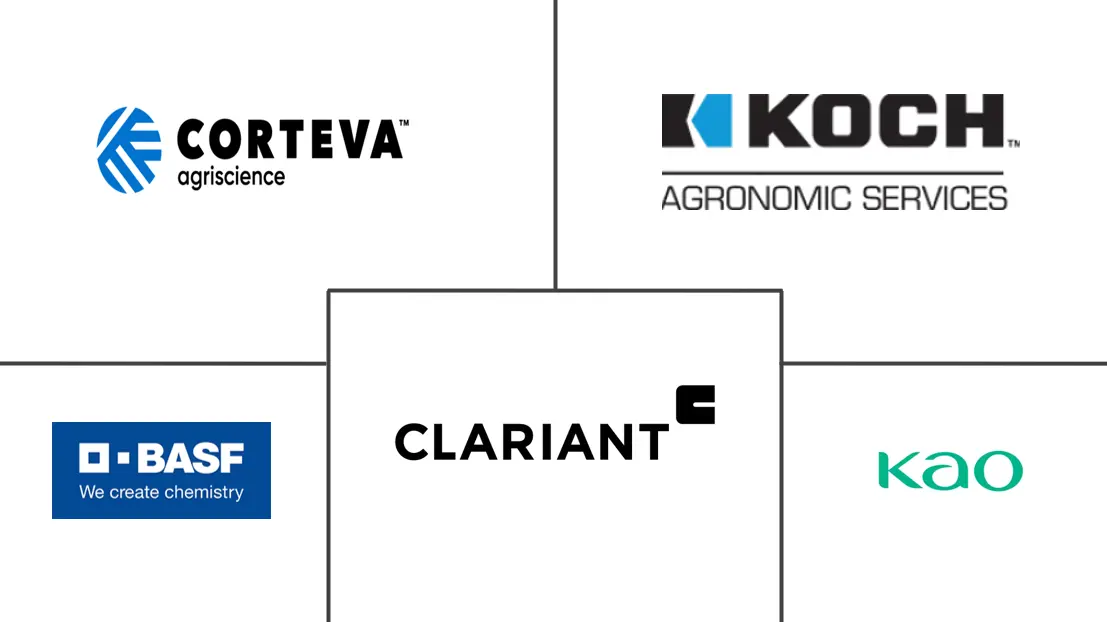Fertilizer Additives Market Size and Share
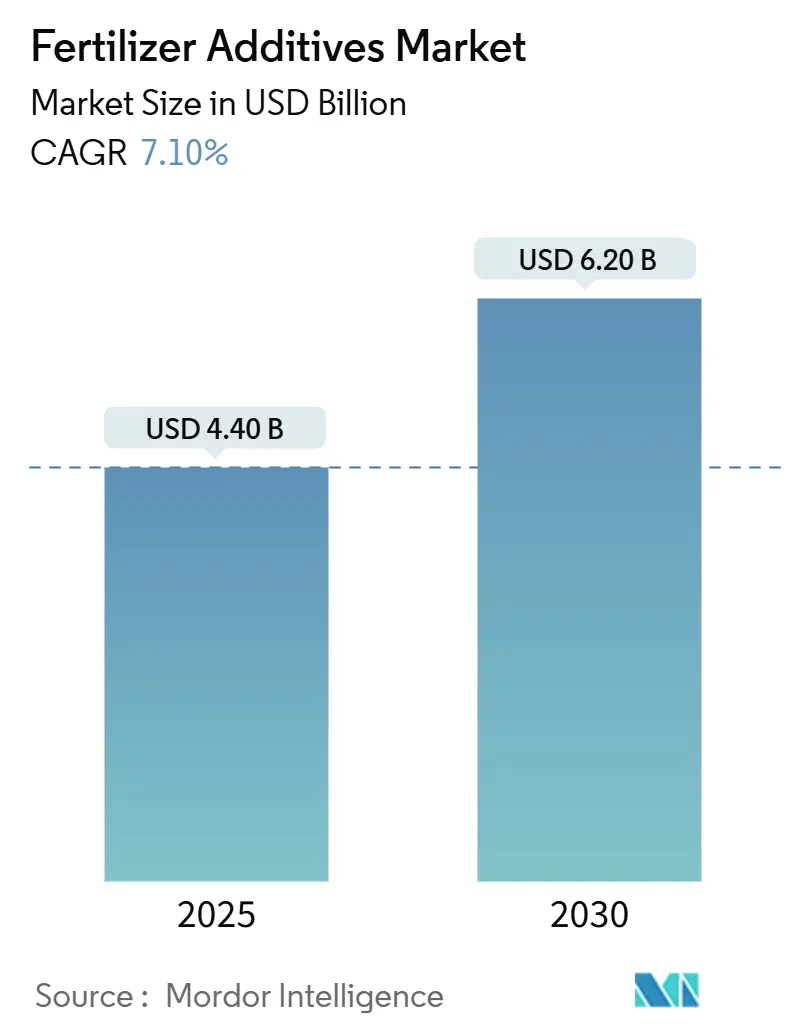
Fertilizer Additives Market Analysis by Mordor Intelligence
The fertilizer additives market stood at USD 4.40 billion in 2025 and will advance to USD 6.20 billion by 2030, reflecting a steady 7.10% CAGR through the outlook period[1]Source: United States Department of Agriculture, “Farm Computer Usage and Ownership Highlights,” usda.gov . Growth rests on stricter nutrient-use rules, the surge of precision agriculture, and rising input costs that push growers toward additives that guard every unit of applied nitrogen or phosphate. Enhanced-efficiency products now pair with variable-rate technology, which already covers 37% of U.S. corn acres, bringing micro-dosing accuracy to fields and irrigation pivots alike. Asia-Pacific supplies the volume base, Africa supplies the pace, and both regions rely on anti-caking and coating chemistries to preserve flowability from the plant gate to the planter box. Demand is also forming around cryogenic ammonia logistics as green ammonia projects multiply, requiring agents that remain active at –33 °C storage temperatures. Moderate concentration among suppliers leaves room for innovators that combine biological stabilizers, biopolymer coatings, and digital dosing support into a single performance package.
Key Report Takeaways
- By function, anti-caking agents held 37% of the fertilizer additives market share in 2024, while coating agents will expand at a 9.8% CAGR to 2030.
- By form, solid additives accounted for 68% share of the fertilizer additives market size in 2024; liquid formats are projected to grow at 8.4% CAGR over 2025-2030.
- By application, urea captured 42% of the fertilizer additives market share in 2024, whereas ammonium sulfate additives will rise at an 11% CAGR through 2030.
- By crop, cereals and grains accounted for 54% of the fertilizer additives market share in 2024; fruits and vegetables are projected to grow at 10.6% CAGR over 2025-2030.
- By region, Asia-Pacific led with a 39% revenue share in 2024, while Africa is forecast to post the fastest 10.5% CAGR out to 2030.
- The five largest suppliers controlled 36% of global revenues in 2024, led by Corteva at 13% and BASF at 7%.
Global Fertilizer Additives Market Trends and Insights
Drivers Impact Analysis
| Driver | (~) % Impact on CAGR Forecast | Geographic Relevance | Impact Timeline |
|---|---|---|---|
| Rising fertilizer consumption in high-intensity farming regions | +1.2% | Asia-Pacific, North America | Medium term (2-4 years) |
| Demand for enhanced-efficiency fertilizers | +1.8% | Global, especially North America and Europe | Long term (≥ 4 years) |
| Regulatory push for nutrient-use efficiency | +1.1% | Europe, North America | Medium term (2-4 years) |
| Precision-agriculture adoption enables micro-dosing | +0.9% | North America, Europe, Australia | Long term (≥ 4 years) |
| Cryogenic low-carbon ammonia logistics | +0.4% | Japan, Europe, Middle East | Long term (≥ 4 years) |
| Soil-microbiome-friendly biopolymer coatings | +0.7% | Global, early uptake in Europe and North America | Long term (≥ 4 years) |
| Source: Mordor Intelligence | |||
Rising Fertilizer Consumption in High-Intensity Farming Regions
Surging cereal demand lifts additive volumes in zones that already farm at maximum intensity. The OECD-FAO Outlook sees global cereals hitting 3.1 billion tons by 2032, most of it from Asia and Africa[2]Source: OECD and FAO, “Agricultural Outlook 2024-2033,” oecd.org . Additives arrest nutrient losses that climb in humid, irrigated systems, and more than 5 million acres now run on enhanced formulations that cut volatilization during fertigation worldfertilizer.com. Growers using drip and pivot systems achieve nutrient-use efficiency near 90%, propelling further uptake of anti-caking and coating chemistries that keep blends free-flowing under high humidity. Capital inflows toward food security create predictable long-term demand curves for additive suppliers.
Demand for Enhanced-Efficiency Fertilizers (EEF)
Value-added fertilizers worth USD 19.8 billion merge biostimulants, inhibitors, and controlled-release coatings into single granules tailored for timing and crop phase. Urease inhibitors such as NBPT lower ammonia losses by 54% when matched with Duromide stabilizer, helping growers derive higher protein grain without extra passes. U.S. biostimulant sales will triple to USD 1.2 billion by 2026, embedding biologicals into conventional nutrient programs. Polymer-coated controlled-release variants further tighten delivery windows, nudging the fertilizer additives market toward smarter, multi-layer films that synchronize supply and root demand.
Regulatory Push for Nutrient-Use Efficiency
The European Union’s Fertilizer Regulation (EU 2019/1009) unifies labeling and safety rules across all fertilizer categories and bars sales of products cleared under prior statutes, forcing reformulations built on lower-carbon inputs. The U.S. EPA is weaving endangered-species safeguards into pesticide registration, indirectly steering growers toward formulations that curb nitrogen losses and runoff. In livestock-dense regions, nitrification inhibitors such as nitrapyrin are being written into manure management codes to trim nitrous oxide emissions. Taken together, these policies accelerate the adoption of additives that document higher nutrient-use efficiency.
Cryogenic Low-Carbon Ammonia Logistics Creating New Anti-Caking Needs
A pipeline of 180 million tons of low-carbon ammonia projects aims for commissioning by 2035, positioning ammonia as cargo for energy and fertilizer alike. Japan targets 20 million tons of ammonia and hydrogen usage by 2050 and channels subsidies to import terminals and co-firing plants. Storage at –33 °C causes conventional anti-caking waxes to fracture, spurring research into elastomeric agents that maintain film integrity under thermal shock[3]Source: United States Department of Agriculture, “Farm Computer Usage and Ownership Highlights,” usda.gov . This niche stimulates additive makers to tailor products for maritime cold chains.
Restraints Impact Analysis
| Restraint | (~) % Impact on CAGR Forecast | Geographic Relevance | Impact Timeline |
|---|---|---|---|
| Rising cost of crop inputs | −0.8% | Global, developing regions | Short term (≤ 2 years) |
| Tightening environmental regulations on additives | −0.6% | Europe, North America | Medium term (2-4 years) |
| Petrochemical feedstock volatility for specialty surfactants | −0.5% | Global, emphasis on Asia-Pacific | Short term (≤ 2 years) |
| Rapid emergence of biological substitutes | −0.7% | North America, Europe | Long term (≥ 4 years) |
| Source: Mordor Intelligence | |||
Rising Cost of Crop Inputs
Fertilizer prices rose 11% in early 2025, squeezing farm margins as grain prices lag[4]Source: World Bank, “Commodity Markets Outlook April 2025,” worldbank.org. Delivered UAN28 reached USD 354 per ton, DAP USD 765, and MAP USD 810, making premium additives a harder sell for cash-strapped growers. Rabobank’s affordability index signals demand destruction risk, especially in nitrogen and phosphate categories that already command the bulk of farm spend. Smallholders in Africa and South Asia face the harshest trade-offs, often deferring enhanced-efficiency purchases despite proven payback.
Tightening Environmental Regulations on Additives
The European Chemicals Agency wants stricter workplace exposure limits for amorphous silica, a mainstay of flow conditioners, raising compliance costs for formulators. Microplastics legislation is pushing polymer-coated granule producers toward biodegradable films, spurring expensive reformulation programs. Long-term ecotoxicity of synthetic nitrification inhibitors is under review, and precautionary bans could jolt established product lines in the fertilizer additives market.
Segment Analysis
By Function: Anti-Caking Dominance Amid Coating Innovation
Anti-caking products generated the largest slice of the fertilizer additives market in 2024, at 37% of revenue. This dominance stems from the material’s vital role in preserving particle flow during humid shipping seasons and long warehouse layovers. Fatty amine blends and reduced-surfactant systems now outperform early bio-waxes by creating thinner, more flexible films that withstand compression in rail cars. Coating agents, however, wear the growth crown with a 9.8% CAGR, propelled by polymer and biopolymer films that meter release over 45- to 90-day spans. These twin leaders show how reliability and nutrient timing together move purchasing decisions.
Second-tier categories also evolve. Inhibitors answer regulatory calls to curb nitrous oxide, and granulation aids win converts in precision applicators that demand tight particle tolerances. Emerging hybrid products fuse anti-caking, inhibitor, and coating functions into single additives that cut inclusion rates and simplify supply chains. Corrosion prevention solutions enter liquid fertilizer service while dedusting agents gain momentum where worker exposure standards tighten. The fertilizer additives market continues to gravitate toward multi-purpose chemistries able to solve several pain points with one dose.
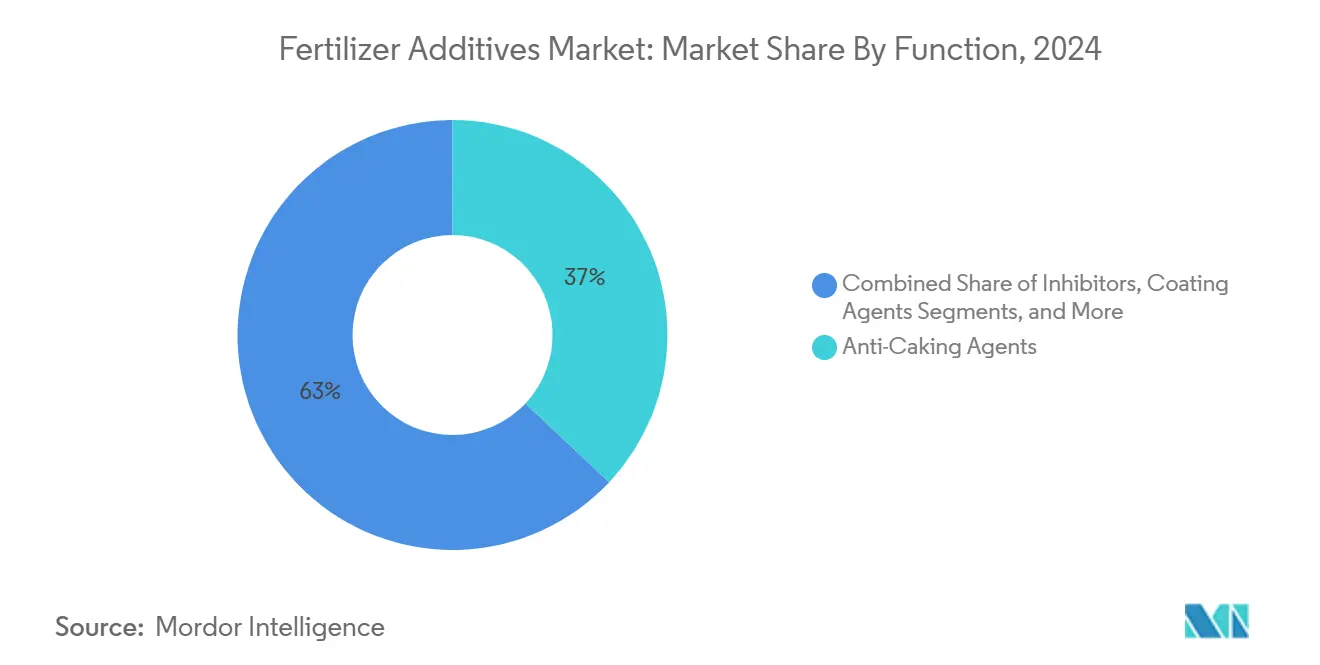
Note: Segment share of all individual segments available upon report purchase
By Form: Solid Foundation with Liquid Growth
Granular nutrient blends keep solids on top, translating to 68% of revenues and steady cash flows for talc-based conditioners, waxes, and fatty amine powders. Bulk terminals and barge operators rely on solid anti-caking to keep piles free-flowing. Liquids, though smaller, are the climbers, logging an 8.4% CAGR that mirrors rising fertigation acres and drone spray adoption. Liquid dispersions dissolve quickly in nurse tanks, enabling inline injection at variable rates that match yield maps.
Micro-encapsulated formats sit between the two poles. They protect active ingredients, delay the release, and satisfy looming microplastic rules with compostable shells made from polylactic acid or starch. Milliken’s push into microcapsules illustrates capital migration toward next-generation delivery routes. In the fertilizer additives market, form factors are converging; some suppliers now offer kits that include both liquid seed dressing and companion dry coating for top-dress passes, ensuring consistent nutrient control across the season.
By Application: Urea Leadership with Specialty Growth
Urea’s share, 42% of total demand, anchors the fertilizer additives market share due to its low cost and high nitrogen density. Unfortunately, urea also volatilizes quickly. NBPT and other urease inhibitors, therefore, remain cornerstones of many additive portfolios, often paired with thin polymer shells that stretch nitrogen availability past three weeks. Specialty niches arise in ammonium sulfate, which gains an 11% CAGR, spurred by precision-guided sulfur programs for oilseed and horticulture.
DAP and MAP depend on moisture blockers that stop phosphate cakes from forming during tropical storage. Ammonium nitrate coatings must pull double-duty—block caking yet not alter explosive safety classifications. Triple super-phosphate and potash blend lean on dust suppressants to protect conveyor workers and keep micronutrient coatings intact. Each substrate invites a different additive recipe, prompting suppliers to engineer modular product lines that can be tuned field-side.
By Crop: Cereals Dominance with Horticultural Expansion
Cereals and grains account for 54% of additive usage as they occupy most cropland and consume nitrogen and phosphate at an industrial scale. Optimized NPK regimens boost cereal output by more than 55%, a figure that underscores why flowability and inhibitor efficiency sit at the center of grower budgets. Adopters in this segment gravitate toward coatings that combine slow release and anti-dust in one pass.
Fruits and vegetables grow at 10.6% CAGR because their higher market price justifies premium inputs such as nano-chelates and hydrogels that target root zones with minute precision. Oilseeds demand boron and sulfur balancing, which pushes micronutrient additives faster than overall nitrogen stabilizers. Turf and ornamentals rely on polymer-coated prills that feed gradually over 90 days, lowering mowing frequency and labor costs. Crop specificity will keep the fertilizer additives industry agile as suppliers jockey to tailor SKUs by commodity and region.
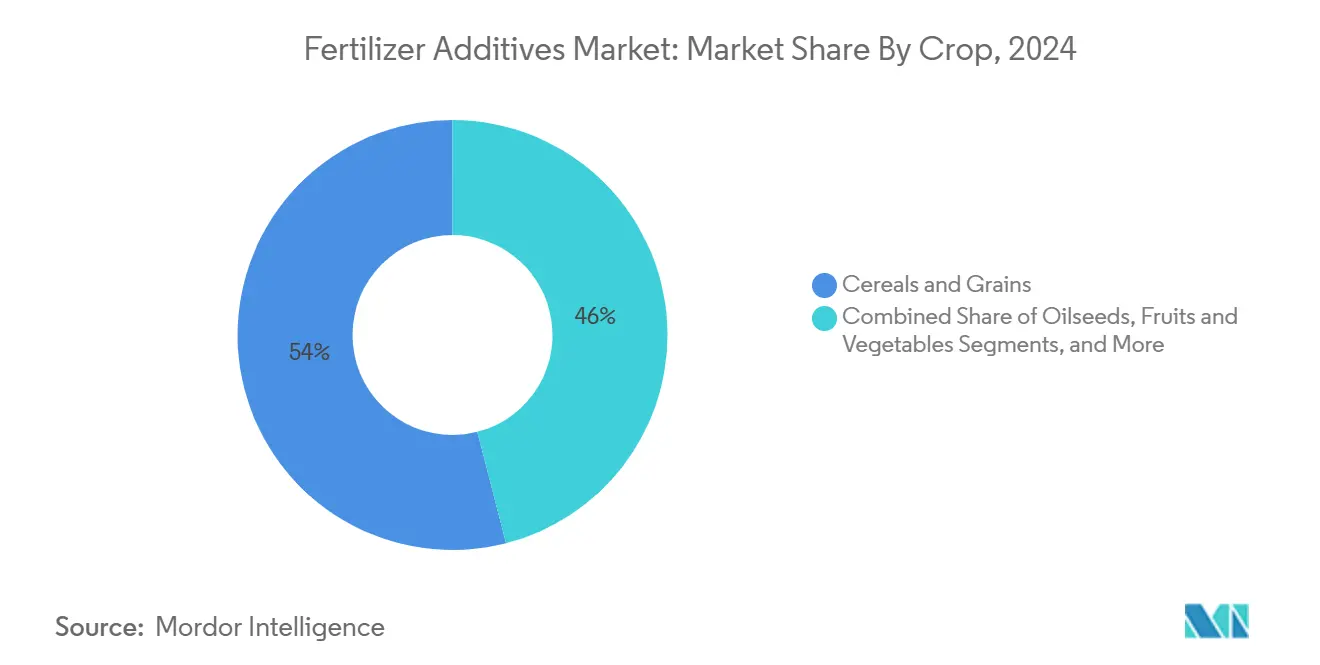
Note: Segment share of all individual segments available upon report purchase
Geography Analysis
Asia-Pacific retained the sales crown at 39% in 2024 thanks to dense small-plot farms in China and India that collectively serve nearly 3 billion people. Domestic additive lines benefit from China’s temporary phosphate export limits, which reshuffle supply into local channels and dampen import reliance. India’s chemicals sector is on track to touch USD 50 billion in specialty revenues by 2025, aided by the Digital Agriculture Mission that funds soil labs and on-farm sensors. Within the fertilizer additives market size, domestic producers leverage integrated supply chains to keep delivered costs low despite volatile freight markets.
Africa showcases the fastest 10.5% CAGR as governments and private capital pour funds into new production hubs. Consumption will jump from 7.6 million to 13.6 million tons of nutrients by decade's end, led by Nigeria’s 1.5 million ton plant and Indorama’s 2.8 million ton expansion. West Africa alone could exceed 4.6 million tons by 2030. Adoption still faces last-mile hurdles such as bagged product costs and rural financing gaps, but additive suppliers see room to package flow conditioners with farmer training to lift acceptance.
North America and Europe register mature yet innovative growth at 5.2% and 4.5% CAGR. Precision agriculture underpins most incremental demand; 28% of U.K. farms adjust fertilizer plans using legume rotations to fix nitrogen and curb synthetic application[5]Source: Department for Environment, Food and Rural Affairs, “Farming Statistics: Fertiliser Usage on Farms 2024,” gov.uk. The EU Carbon Border Adjustment Mechanism, coming in 2026, will require fertilizer importers to disclose embedded carbon, advantaging local low-emission formulations. Across both continents, biological alternatives gain a share, yet chemical coatings persist because their performance data remain robust under colder climates and tight planting windows.
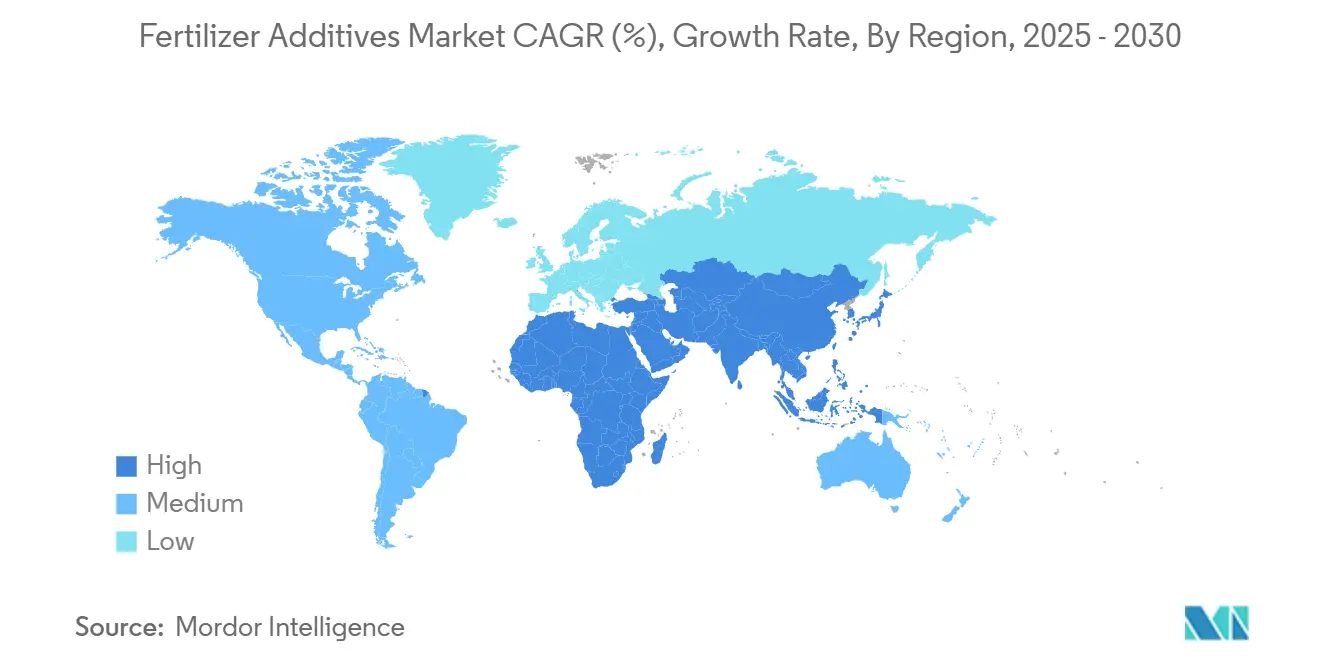
Competitive Landscape
The fertilizer additives market remains moderately concentrated, with the top five companies accounting for 36% of 2024 revenue. Corteva Agriscience leads at 13%, buoyed by nitrogen stabilizers that plug directly into its seed and crop-protection platforms. BASF follows at 7%, leveraging a global production footprint and a broad anti-caking and coating portfolio, even as it weighs an agricultural unit IPO to sharpen strategic focus. Arkema’s ArrMaz unit and KAO Corporation each capture 6%, the former through specialty surfactants and the latter via proprietary fatty-amine chemistries used in advanced coatings. Clariant rounds out the top tier at 4%, supplying high-purity surfactants that improve flowability and reduce dust during bulk handling.
The strategy now tilts toward sustainability and geographic diversification. Corteva has expanded its biological arm with the Symborg and Stoller deals, positioning itself to bundle living inoculants with chemical stabilizers. BASF channels R and D into biodegradable films that satisfy European microplastic rules, while Arkema adapts green surfactants for low-temperature ammonia logistics. KAO refines fatty-amine blends to boost coating efficiency at lower inclusion rates, and Clariant pilots sugar-derived dust suppressants designed for warmer, high-humidity supply chains. ICL Group, though outside the top five, underscores the trend by buying Nitro 1000 and launching biological nitrogen-fixation products in Brazil.
White-space opportunities persist because 64% of the market remains open to mid-tier and emerging entrants. Demand is building for anti-caking agents that survive cryogenic storage at –33 °C and for microencapsulated additives that align with drone spraying and fertigation. Patent filings concentrate on biopolymer coatings and controlled-release matrices; Evonik’s work on silica carriers for live bacteria highlights the blending of chemical and biological technologies. Suppliers able to prove field performance, environmental compliance, and scalable production are best placed to win share as regulations tighten and growers adopt precision tools at pace.
Fertilizer Additives Industry Leaders
-
BASF SE
-
Corteva Agriscience
-
Clariant International Ltd
-
KAO Corporation
-
Koch Agronomic Services
- *Disclaimer: Major Players sorted in no particular order

Recent Industry Developments
- June 2025: European Chemicals Agency (ECHA) proposed stricter regulations for silicon dioxide (SiO₂) compounds widely used in fertilizer additives, introducing occupational exposure limits and restrictions on consumer product applications, affecting anti-caking and coating agent formulations across the industry.
- March 2025: OCI N.V. completed divestment, generating over USD 6.2 billion in cash proceeds while focusing on lower carbon ammonia production with the Texas Blue Clean Ammonia facility set for 2025 production start, creating new requirements for specialized anti-caking agents capable of handling cryogenic storage conditions.
- December 2024: Saudi Arabia launched a major agricultural technology initiative using carbon-enriched compost additives to enhance soil fertility and water retention, positioning the country as a potential exporter of both organic additive products and technology to combat desertification.
- October 2024: Coromandel International announced expansion plans and new facility establishment to increase fertilizer additive production capacity in India, targeting enhanced anti-caking and coating agent manufacturing capabilities.
Research Methodology Framework and Report Scope
Market Definitions and Key Coverage
Our study defines the fertilizer additives market as all specialty compounds, such as anti-caking agents, granulation aids, coatings, urease or nitrification inhibitors, and dedusting agents, intentionally blended with conventional N, P, K fertilizers to improve nutrient stability, storage, or field performance.
Products that function purely as soil amendments, catalysts used inside ammonia plants, or agrochemical adjuvants not blended into finished fertilizer are kept outside this scope.
Segmentation Overview
- By Function
- Inhibitors
- Coating Agents
- Granulation Aids
- Anti-Caking Agents
- Dedusting Agents
- Corrosion Inhibitors
- Anti-Foaming Agents
- Other Niche Functions
- By Form
- Solid
- Liquid
- Micro-encapsulated
- By Application
- Urea
- Ammonium Nitrate
- Diammonium Phosphate (DAP)
- Mono-Ammonium Phosphate (MAP)
- Ammonium Sulfate
- Triple Superphosphate (TSP)
- Potash Blends
- Other Specialty Fertilizers
- By Crop
- Cereals and Grains
- Oilseeds
- Fruits and Vegetables
- Turf and Ornamentals
- Others
- By Geography
- North America
- United States
- Canada
- Mexico
- Rest of North America
- Europe
- Germany
- France
- United Kingdom
- Spain
- Italy
- Russia
- Rest of Europe
- Asia-Pacific
- China
- India
- Japan
- Australia
- South Korea
- Rest of Asia-Pacific
- Middle East
- Saudi Arabia
- United Arab Emirates
- Rest of Middle East
- Africa
- South Africa
- Egypt
- Rest of Africa
- North America
Detailed Research Methodology and Data Validation
Primary Research
To ground the desk findings, we spoke with agronomists in Brazil, India, the United States, and France, distributors that blend bulk NPK, and procurement heads at large plantations. These interviews helped us verify inhibitor penetration rates, typical dosage per tonne, and emerging price ladders, letting us close information gaps and adjust preliminary assumptions.
Desk Research
We began by extracting baseline supply, demand, and trade cues from open data services such as FAOSTAT, USDA-ERS, Eurostat COMEXT, and the International Fertilizer Association, which outline nutrient application rates and regional cropping patterns. Additional perspective came from policy documents on fertilizer efficiency issued by UNEP and the EU Fertilizer Regulation, plus insights drawn from company 10-Ks and investor decks that reveal average selling prices and additive adoption trends. Our analysts also referenced D&B Hoovers for producer financials and Dow Jones Factiva for recent plant expansions. The sources listed illustrate the breadth of desk work; many other repositories were tapped for validation and clarification.
Market-Sizing & Forecasting
Our model starts with a top-down reconstruction of the global fertilizer pool using country-level nutrient application volumes, which are then filtered through average additive load factors by nutrient type. Results are cross-checked with a selective bottom-up roll-up of major blenders' shipments and sampled ASP × volume calculations, before minor gaps are bridged with channel checks. Key variables fed into the model include: 1) regional nitrogen application intensity, 2) share of fertilizer stored in humid depots, 3) regulatory caps on ammonia volatilization, 4) average farm size influencing bulk-blend usage, and 5) inhibitor price premium versus urea. Forecasts employ multivariate regression, linking those variables to cropland expansion and commodity price outlooks, to project demand through 2030.
Data Validation & Update Cycle
Our team subjects outputs to variance checks against historic trade flows and Statista additive value snapshots before senior-level review. The report is refreshed each year, with interim updates if material events, such as a large anti-caking plant coming online, shift the baseline.
Why Mordor's Fertilizer Additives Baseline Commands Reliability
Published estimates often differ; market values hinge on scope cuts, pricing bases, and refresh cadence.
Key gap drivers include whether coatings and inhibitors are bundled together, how aggressively future ASP compression is assumed, and the currency year applied. Mordor analysts report full-blended additive value at distributor gate in constant 2025 dollars, whereas others may mix factory-gate or farm-gate definitions or use older exchange rates.
Benchmark comparison
| Market Size | Anonymized source | Primary gap driver |
|---|---|---|
| USD 4.40 B (2025) | Mordor Intelligence | - |
| USD 3.50 B (2024) | Global Consultancy A | Excludes coatings; applies farm-gate prices |
| USD 2.99 B (2023) | Trade Journal B | Uses older FX rates and limited geographic coverage |
Taken together, the comparison shows our disciplined scope selection, timely currency normalization, and dual-path modeling give decision-makers a transparent, balanced baseline they can confidently reference when planning capacity or sourcing strategies.
Key Questions Answered in the Report
What are fertilizer additives, and why are they important?
Fertilizer additives are specialized compounds such as anti-caking agents, coatings, and inhibitors that improve storage stability, handling, and nutrient delivery; the fertilizer additives market reached USD 4.4 billion in 2025, underscoring their value in raising nutrient-use efficiency.
Which functional segment currently leads the fertilizer additives market?
Anti-caking agents hold the top spot with 37% revenue share in 2024, although coating agents are projected to rise the fastest at a 9.8% CAGR through 2030.
What region shows the strongest growth outlook for fertilizer additives?
Africa is forecast to post a 10.5% CAGR by 2030 as consumption climbs from 7.6 million to 13.6 million tons on the back of new production hubs and government support.
How are regulations reshaping product development?
Rules such as the European Union Fertilizer Regulation (EU 2019/1009) and the Carbon Border Adjustment Mechanism press suppliers to create low-carbon, biodegradable formulations that still meet performance targets.
What competitive dynamics define the fertilizer additives market?
The market is moderately concentrated; five suppliers control 36% of revenue, yet smaller innovators flourish by focusing on biopolymer films, micro-encapsulated actives, and cryogenic ammonia solutions.
What is the main challenge to near-term demand?
Rising fertilizer prices, up 11% in early 2025, strain farm budgets and may delay the adoption of premium additive technologies, especially among smallholders in developing regions.
Page last updated on:
